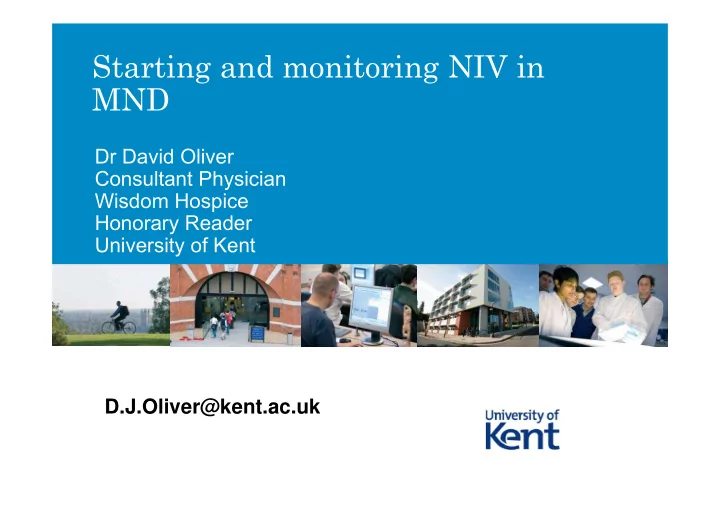

Starting and monitoring NIV in MND Dr David Oliver Consultant Physician Wisdom Hospice Honorary Reader University of Kent D.J.Oliver@kent.ac.uk
Introduction • How do we discuss? • How do we start? • What should we discuss when we start? • How do we monitor?
Monitoring • Ongoing monitoring from diagnosis � Suspicion � SNIP � Oximetry � Symptoms • Orthopnoea • Disturbed sleep • Morning headache • Dreams • Feeling muzzy / unwell
Monitoring • Suspicion � Symptoms � Signs � Investigations • Further investigation � MIP / MEP � Overnight oximetry � Blood gases
Patient issues • Facing multiple losses � Physical • mobility, speech � Cognitive changes � Emotional • expression problems • Fear of disease � Previous experience � “Information” • Fear of death and dying
Communication and discussion • Communication problems � Speech issues � Understanding issues • Cognitive change � Fronto-temporal dementia • 10-15% � Frontal changes and cognitive change • ?50%
Early decision making - benefits • Increased discussion • Involvement of all • Options can be considered carefully • Gradual information giving • Slower decision making • Cognitive impairment less likely
Options and Choices • Clear options presented � Positive and negative aspects • Non judgemental approach • Opportunity for discussion • Time to consider � discussion early enough for consideration � patient not feeling rushed into a decision
Discussion • Ongoing � At all stages opportunity to discuss possible changes � Explanation of testing • Awareness of issues � Patient � Family � Professionals • Joint clinic � Palliative medicine � Respiratory medicine
Starting NIV – discussion of issues • Positives � Symptom management benefit � Sleep improved � Eating � More energy
Starting NIV - discussion of issues • Negative � Disease progression � Issues with mask � Issues coping with NIV � Future planning • Withdrawal • Deterioration • Advance care planning
Starting NIV • At home • Specialist respiratory nurse visit at home • Monitoring � By nurse • In person • Telephone • 24 hour telephone availability � By modem • Continuous monitoring • Checked every day • The settings can be altered remotely
Problems when starting • Negative perception of the mask � Offer masks, try without the machine, listen to the fears • Concerns over “the machine” � Practice, reassurance that the settings cannot be increased by mistake • Pressure tolerance � Ramping (slow increase), ensuring leakage is minimised
Problems when starting • Noise � Place on a towel, ear plugs • Dry mouth � Full face mask, humidification • Leaks � Try new masks, consider removal of beard
Problems when starting • Saliva � Medication � “Some is better than none” � Daytime use • Claustrophobia � Explore possible reasons � Time and patience � Familiarisation � Slow increase in use
Issues with ventilation • Deterioration � Disease still progresses � Increasing risk of reduced communication • Emergency situation � Sudden deterioration � Tracheostomy placed as an emergency � Possibility of becoming “locked in” with tracheostomy
Issues with interventions • Reduced discussion of future � Disease progression � Effectiveness of intervention � Discussion of dying � Preparation • Family � Advance care planning
Advance care planning • Increased awareness and use • Complex issues • Decisions may be difficult to discuss � Person � Family � Professionals • Patient involvement � Potential conflicts in families
Multiple teams • Neurology • Rehabilitation • Specialist palliative care • Respiratory � ventilatory support • Gastroenterology � PEG • Primary Care • Social care
Multiple teams • Complexity of the situation • Differences in � Goals � Roles � Processes � Relationships within the different teams. • Overlap and interaction between � teams � the team members
Co-ordination of care • Need � A proper flow of communication and information for patients and their families � A designated point of contact for each stage in the pathway � A needs assessment identifying the patient’s individual problems
Deterioration • Coping with deterioration � Breathing issues � General deterioration � Cognitive / communication issues • Planning � What will happen? • Medication available • Patient and family aware • Professionals aware • Discussion � Within team � Across teams
Planning ahead • Ensuring all are aware of what to do � Emergency situation � Co-ordination of care • Plans are well known • Back up available
Conclusion • Care is individualised • Complex issues � Physical � Psycho-social � Spiritual • Multidisciplinary assessment • Maximising � Quality of life � Quality of death
Recommend
More recommend